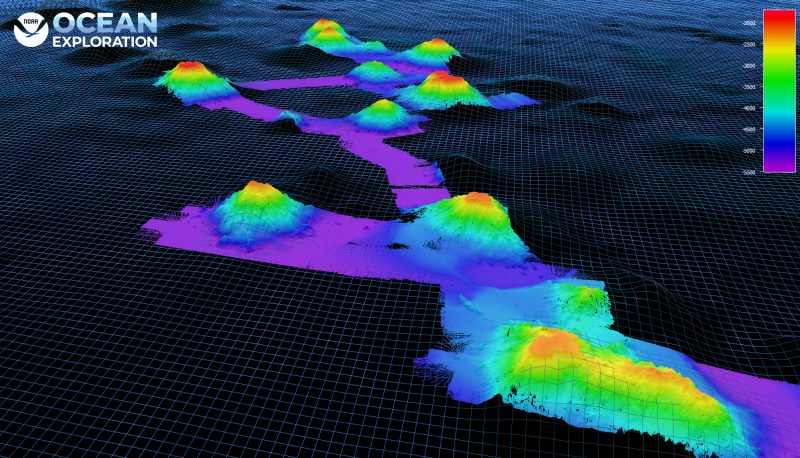
19,000 undersea volcanoes
A team of scientists has discovered more than 19,000 new seamounts – ancient volcanoes – at the bottom of the ocean. The team used satellite data to make the discovery. Data analyst Julie Gevorgian of the Scripps Institution of Oceanography in California led the team that discovered the seamounts. Her team said in a new paper that only 20% of the ocean floor has been mapped by ships. And they said there might be thousands more seamounts yet undiscovered on the ocean floor
Volcanic activity on the ocean floor creates the seamounts, which can rise to around 3 to 10 kilometers (about 2 to 6 miles) high. Smaller seamounts (less than 2 km) are harder to find, according to Claire Watson, who reported on the discovery earlier this month (May 2, 2023) at ScienceAlert. She said they:
… tend to form near mid-ocean ridges where magma pushes through Earth’s thin and fractured crust.
And Watson commented that these underwater mountains can:
… rise thousands of meters in the darkness [of the deep sea], putting unsuspecting submarines at risk.
The American Geophysical Union’s open-access journal Earth and Space Sciences published the new study online on April 6, 2023.
Here’s how they found the volcanoes
According to the National Oceanic and Atmospheric Administration, three-quarters of all Earth’s volcanic activity happens underwater. But – just as on Earth – the undersea volcanoes aren’t all active.
So how can we find the seamounts? Ships can detect them via sonar, a technique that uses sound waves to bounce off the ocean floor. But that can happen only when the ships happen to pass over the seamounts.
Gevorgian’s team used a different technique – called satellite altimetry – which lets scientists measure changes not in the sea floor itself, but in the sea surface height. A change in the height of the sea surface can, in turn, reflect an increased pull of gravity coming from the presence of the seamounts (the volcanoes) on the sea floor. Watson wrote:
The larger the mound, the more its gravitational pull draws in seawater on top.
Using this method, Gevorgian and colleagues identified 19,325 new undersea volcanoes, adding to the 24,643 mapped seamounts that two members of the team had previously cataloged back in 2011 and ironing out some mistakes in the process.
In fact, that brings the total to 43,454 undersea mountains, almost doubling the number we knew about.
She wrote that many of the newly discovered seamounts were previously too small to be detectable in satellite data. But:
… Recent advances to expand coverage and improve the accuracy of satellite data from the European Space Agency’s CryoSat-2 satellite and SARAL, the Indian and French space agencies’ version, changed the picture.
Why study seamounts?
According to NatureWorldNews.com:
Scientists can better understand the tectonic plates and the geomagnetic field of the Earth by mapping the locations of seamounts.
According to the study, volcanoes can provide information about the makeup and temperature of the Earth’s mantle.
And deep ocean currents are impacted by seamounts. When currents and seamounts interact, the currents are pushed upward and carry cold water …
[Finally], since seamounts are rich in minerals and can serve as a habitat for a variety of marine life, scientists have set out to explore and map out as many seamounts as they can to learn more about what lies beneath the ocean’s surface.
Bottom line: A team of scientists has just discovered more than 19,000 ancient volcanoes – aka seamounts – at the bottom of the ocean.
Source: Global Distribution and Morphology of Small Seamounts











